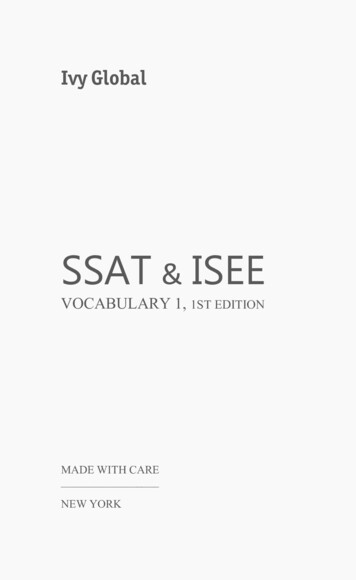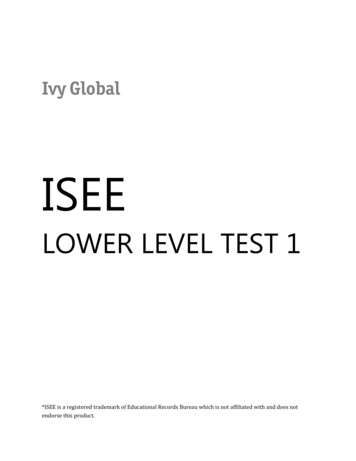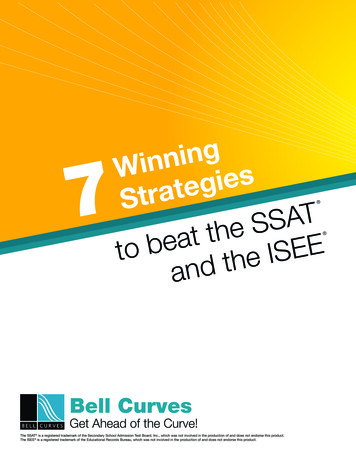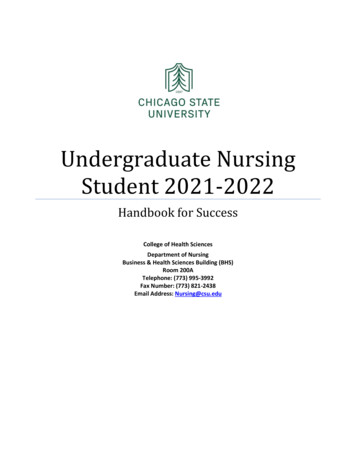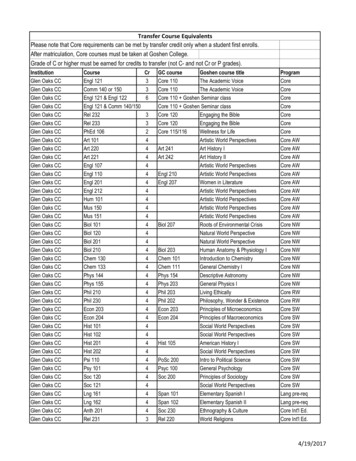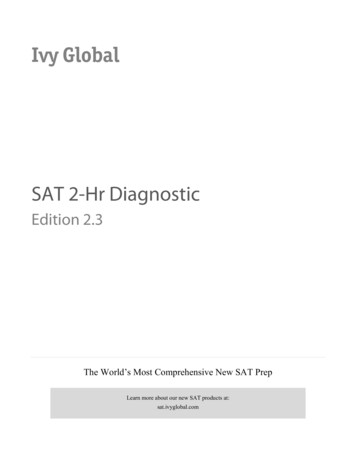
Transcription
Ivy GlobalISEE ENGLISHLook inside this book: Table of Contents Sentence Completion Practice Questions (p 89-92) Critical Reading Strategies (p 115-125) Reading Comprehension Practice Questions (p 156-159, p201-206) Common Word Roots, Prefixes, and Suffixes (p 284-289)Version 1.0Distribution of our PDF files without consent is prohibited by law. Downloaded files may include a digital signature to trackillegal distribution. Suspected piracy may also be reported to the US ISBN agency.ISEE is a registered trademark of the Educational Records Bureau, which is not affiliated with and does not endorse this product.
CONTENTSCHAPTER 1: INTRODUCTION . 1How to Use this Book . 3About the ISEE . 5CHAPTER 2: TEST-TAKING STRATEGIES . 11Approaching the ISEE . 13CHAPTER 3: VERBAL REASONING . 29Introduction . 31Part 1: Synonyms . 33Synonym Strategies . 34Synonym Practice Questions . 46Part 2: Sentence Completion . 71Sentence Completion Strategies . 72Sentence Completion Practice Questions . 87CHAPTER 4: READING COMPREHENSION . 113Introduction . 115Critical Reading Strategies . 117Types of Passages . 129Types of Questions . 141Reading Comprehension Practice Questions . 156CHAPTER 5: THE ESSAY . 217Introduction . 219Writing Basics . 221
Structuring Your Essay . 235Essay Strategies . 250Sample Essay Prompts . 267CHAPTER 6: VOCABULARY BUILDING . 269Introduction . 271Word Roots, Prefixes, and Suffixes . 277ISEE Core Vocabulary . 290CHAPTER 7: ANSWER KEYS . 355Verbal Reasoning . 357Reading Comprehension . 362The Essay . 364Vocabulary Building . 366
BASIC QUESTIONSUse these questions to practice the most basic difficulty level you might see on the Lower,Middle, and Upper Level ISEE. The Lower Level exam will include more basic questionsthan the Middle and Upper Levels. Phrase responses will only occur on the Lower Level.1. After negotiating the price with thecar salesman, David and Pete -------a yellow convertible.(A) purchased4. It is important to discuss the -------of an experiment so that otherresearchers can know what steps tofollow when repeating it.(B) salvaged(A) methods(C) debated(B) defenses(D) approximated(C) specks(D) communications2. While millions of people around theworld have heard of the Taj Mahal,--------.(A) Shah Jahan used new techniquesto build it.5. After she saw her dog chew throughher pillows, Hannah realized thatonly training would stop theanimal's -------- behavior.(B) it was built as a tribute to ShahJahan’s wife.(A) weary(C) only a small percentage ofpeople have actually seen it.(C) stationary(D) many scholars have tried toexplain why the monument is sopopular.3. Jane and Monica made a pact to stayfriends forever, and they fulfilledthis -------- by remaining friendsuntil the ends of their lives.(A) vow(B) parody(C) devotion(B) unruly(D) comical6. Because the reservoir contained thetown’s drinking water, --------.(A) no one was allowed to swim init.(B) people thought it seemedspooky at night.(C) different reservoirs servedifferent purposes.(D) Lucy spent long hours readingin the park near it.(D) incisionVERBAL REASONING 89Ivy Global
7. For her submission to anarchitecture design contest, thearchitect -------- a plan for a newkind of skyscraper.11. Because the king had -------- that hisneighbors were weak, he wassurprised to discover that theyactually had strong armies.(A) developed(A) inquired(B) inspired(B) assumed(C) competed(C) overthrew(D) pressured(D) revealed8. Katie -------- her older sister bypulling her hair and calling hernames.12. Although the rest of her family wasnot particularly musical, Annettehad a -------- for playing the piano.(A) pacified(A) talent(B) tormented(B) dialect(C) detested(C) tact(D) entrusted(D) distress9. Although Helen Keller was both deafand blind, --------.(A) Anne Sullivan was her teacher.(B) she learned to communicatewith others.13. The trade of -------- pets such astigers, lions, and wolf-hybrids isillegal, yet people still import theseanimals from foreign countries.(A) domestic(C) it was challenging for her tolearn sign language.(B) exotic(D) she had scarlet fever at the ageof two.(D) alarmed10. Ted was so cheerful and goodspirited that he laughed -------- ateveryone’s jokes, even the bad ones.(A) blandly(B) identically(C) aggressively(D) heartilyVERBAL REASONING 90(C) aquatic14. Clara’s passion for exploring in thewild led her to --------.(A) venture deep into the forest.(B) attempt to read difficult books.(C) boast of never having traveledoutside her town.(D) contest those who said theyknew less about animals thanshe did.Ivy Global
15. Because Anna Pavlova was such an-------- dancer, she became one ofthe most famous ballerinas in theworld.(A) endangered(B) obvious(C) accomplished(D) exasperated16. As a responsible pet owner, Annanever -------- to feed her hamster.(A) suffocated(B) neglected(C) prevented(D) desired17. Although many of Jules Verne’sbooks discuss his characters’ --------,Verne himself traveled very little inhis life.(A) myths(B) voyages(C) illustrations(D) strategies18. Using clever deception, the -------fox was able to outwit the hunter.19. While many think that Watson andCrick were the first to identifyDNA’s double helix, --------.(A) they worked together on thisdiscovery.(B) Maurice Wilkins was theirresearch assistant at the time.(C) some argue that RosalindFranklin made this discoverybefore them.(D) they were honored for theirfindings with a Nobel Prize in1962.20. For Madeline, completing the entiremarathon was an -------- on its own;she was proud to have finished, andit did not matter how long she hadtaken.(A) achievement(B) ideal(C) obstacle(D) enhancement21. While some celebrities are --------,others frequently boast about theirtalents.(A) eager(A) highbrow(B) peculiar(B) somber(C) bitter(C) cunning(D) humble(D) superbIvy GlobalVERBAL REASONING 91
22. Henry David Thoreau wanted a lifeaway from civilization, so he --------.(A) wrote the book Walden.26. Alice’s life was so busy as an adultthat she often thought back to hercarefree childhood, when --------.(B) went to live in the woods on hisown.(A) she had no worries.(C) worked as an elementary schoolteacher before moving toConcord.(C) her mother gave her manychores.(D) influenced many prominentthinkers, including MartinLuther King.23. When the employers realized thattheir employee had swindled them,they were so -------- that they couldnot think clearly.(B) she never had time to relax.(D) her school life had been veryproblematic.27. After an apple fell onto Sir IsaacNewton’s head, he had the -------that gravity is what causes objectsto fall.(A) jubilation(B) frustration(A) cautious(C) hesitation(B) serious(D) realization(C) furious(D) nervous24. After the captain lost her compass,she found it very difficult to -------her ship.28. After being cooped up in aclassroom for hours, it can be quite-------- for students to go playoutside.(A) liberating(A) terminate(B) abolishing(B) innovate(C) challenging(C) inundate(D) reassuring(D) navigate25. All of the author’s works revolvearound a main character and hertrusted --------, who accompaniesher on her adventures.(A) antagonist(B) pedestrian(C) companion(D) duplicateVERBAL REASONING 9229. It is only after a hypothesis is testedmany times that --------.(A) it can be considered proven.(B) it should not be tested onanimals.(C) it will be doubted by thescientific community.(D) researchers will test it in anexperiment.Ivy Global
INTRODUCTIONSECTION 1The ISEE Reading Comprehension section tests your ability to understand short passagesfrom a variety of different sources. If you are taking the ISEE Lower Level, you will answer25 total questions based on 5 passages (5 questions per passage). If you are taking the ISEEMiddle or Upper Levels, you will answer 36 total questions based on 6 passages (6questions per passage). Genres may include informative passages, persuasive passages, andnarrative passages. You will be asked answer questions about the author’s main idea,supporting information, argument organization, and writing style. You may also be asked toinfer conclusions not explicitly stated in the passage by expanding logically on the author’sargument. However, you will never need to rely on any of your own prior knowledge aboutthe material; all of the information needed to answer these questions will be given directlyin the passage.APPROACHING THE READING SECTIONTIME MANAGEMENTPace yourself carefully. You are only given points for answering the questions, not readingthe passages, so don’t spend too long reading any one passage. Focus on the shorterpassages first and save the longer passages for last. If you are unsure about a question,make your best guess and move on—you can always come back to the question if you havetime at the end. If you are close to running out of time, see if there are any questions youcan answer quickly by reading just a few lines in the passage, and make your best guess onany other questions you have left.Read quickly, trying to understand the main points of the passage rather than the smalldetails. Don’t waste time trying to understand every piece of information in the passage. Ifsomething doesn’t make sense to you, try to get an overall sense of what the author issaying and move on.Ivy GlobalTHE READING SECTION 115
ANSWER QUESTIONS OUT OF ORDERAnswer questions about the main idea or the main purpose first, and then turn to questionsthat ask about specific details in the passage. If a question looks like it will take a long timeto answer, make your best guess, circle it, and come back to it if you have time at the end ofthe section.PROCESS OF ELIMINATIONUse the Process of Elimination to narrow down your answer choices, eliminating answersthat are obviously wrong or have nothing to do with what is being asked. Then decideamong the remaining answer choices which one best answers the question. Remember thatyou are being asked to find the best answer, not the one that immediately seems correct.Check all of the possible answer choices before making your selection.VOCABULARY BUILDINGUse your practice reading passages to help develop your vocabulary. Circle words you don’tunderstand, look them up, and add them to your vocabulary flashcards or journal.THE READING SECTION 116Ivy Global
CRITICAL READING STRATEGIESSECTION 2The Reading Comprehension section on the ISEE doesn’t only test whether you are able tounderstand a passage. The section also tests whether you are able to read critically, whichmeans examining and interpreting what the passage means as a whole. This means that youshould look not only for the facts of the passage, but also what the author is saying aboutthose facts and how the author is saying it.For every passage you read, ask yourself:1. What are the author’s topics, or the key details being discussed in this passage?2. What is the author saying about these topics, or what is the main point of thepassage?3. What is the author’s purpose in this passage?In this section, we’ll discuss how to go about answering these questions. We’ll take a look atseveral strategies that will build your critical reading skills and help you become a moreactive reader for the ISEE. Because you have a unique learning style, some of thesestrategies might work better for you than others. Identify the strategies that help you themost, and practice using these for each new passage you read.UNDERSTANDING THE PASSAGEYour first step to understand the passage is to identify the basic facts that the author isdiscussing. As you read, stop yourself after each paragraph and take the time to mentallysummarize the basic facts that you have read. Summarizing these basic facts in your ownwords is important because it allows you to prove to yourself that you have reallyunderstood what the passage is saying. The questions on the ISEE might also ask you torecognize concepts from the passage in slightly different words, so you can’t be tied downto the exact words that the author uses.Ivy GlobalTHE READING SECTION 117
THE 5 W’SWhat is the best way to quickly summarize the passage? You may have heard about the 5w’s: “who,” “what,” “where,” “when,” and “why.” As you read, ask yourself these fivequestions:1. Who is involved in this passage? Look for any people being discussed and thinkabout who might be writing this passage.2. What is being discussed in this passage? Look for the major concepts in eachsection of the passage.3. Where are the events in this passage taking place? Look for any important placesthat are being discussed.4. When are the events in the passage taking place? Look for any clues that might tellyou the dates of the events taking place. Also see if you can guess when the authormight have written the passage.5. Why is the information in this passage important? In other words, how are theideas in the passage connected, and what purpose or main point is the authorillustrating with all of these details? We’ll discuss this in greater detail in the nextsection.KEY WORDSAs you read, underline the key words that answer these questions in the passage. Be anactive reader and read with your pencil! Underlining as you read will improve yourconcentration and keep you focused on the most important information in the passage.Identify whether the words you underline answer the questions “who,” “what,” “where,”“when,” or “why.”As you read, also pay close attention to how the author connects information within thepassage. Underline any transitional words or phrases that the author uses to move fromone idea to another. The author might use words like “additionally,” “furthermore,” or“consequently” to show how one idea follows from or supports another. She might usewords like “but,” “yet,” or “however” to show how one idea contrasts with another.Take a look at the example passage below. What key words would you underline to answerthe questions “who,” “what,” “where,” “when,” and “why”? What other transitional wordswould you underline? You might try something like this:THE READING SECTION 118Ivy Global
123456789101112131415161718The duck-billed platypus is asmall animal, native to Australia,with many unusual characteristics. Itis a very odd-looking animal; in fact,when Europeans first heard aboutthe platypus, many thought such anodd-looking animal must be a fraud.Its head and feet are like a duck’s, itsbody is like a weasel’s, and its tail islike a beaver's. Its webbed feet help itswim, its odd-shaped tail helps it tostore fat, and its duck-like beak helpsit find food in rivers.A platypus is a mammal, but isremarkably unlike almost everyother mammal. The platypus layseggs; it doesn't give birth like othermammals. Also, although all1920212223242526272829303132333435mammals give their young milk, theplatypus has an unusual way of doingthis: it actually sweats milk all overits body. But despite thesedifferences, the platypus has fur, likeother mammals.Finally, the platypus has someamazing abilities. The platypus cansee electricity: it senses electricitycoming from other animals in thewater and uses this ability to catchfood and avoid predators. Theplatypus also has venomous spurs onits feet that allow it to defend itself.An animal that gets too close to theplatypus’s feet will be stung with apoison.Let’s see how these key words helped us answer the 5 w’s for this passage:1. Who is being discussed in this passage? This passage is about the duck-billedplatypus, which is the first word we underlined.2. What is being discussed in this passage? This passage focuses on several unusualcharacteristics of the duck-billed platypus: its odd looks, difference from othermammals, and amazing abilities. We underlined these characteristics in thepassage.3. Where are the events in this passage taking place? The passage says that the duckbilled platypus lives in Australia, so we underlined that place in the passage.4. When are the events in this passage taking place? This passage doesn’t specificallytell us this information. But because the passage is written in the present tense, wecan assume that it is talking about a type of animal that is alive today.5. Why is the information in this passage important? We underlined the transitionalwords “but,” “despite,” and “finally” in order to keep track of how the ideas in thispassage support or contrast with each other. We’ll talk about the author’s main ideaand purpose in the next section, but all of the information included in this passageseems to be describing why the platypus is unusual.You might have decided that other concepts are also important, and might have underlinedsome additional words. However, don’t underline too many words in any paragraph! Onlyfocus on the key words, those that are the most important and those that answer the 5 w’sfor the passage.Ivy GlobalTHE READING SECTION 119
Exercise #1: Read the following passages and underline the key words that answer thequestions “who,” “what,” “where,” “when”, and “why,” as well as any transitional words orphrases. Then, use these key words to answer the 5 w’s in your own words. Have a trustedreader check your work.123456789101112131415161718192021A banana split is an ice creambased dessert. In its classic form, it isserved in a long dish called a boat. Abanana is cut in half lengthwise andlaid in the dish. There are manyvariations, but the classic bananasplit is made with scoops of vanilla,chocolate and strawberry ice creamserved in a row between the splitbanana. Pineapple topping isspooned over the strawberry icecream, chocolate syrup over thevanilla, and strawberry topping overthe chocolate. It is garnished withcrushed nuts, whipped cream, andmaraschino cherries.David Evans Strickler, a 23year-old apprentice pharmacist atTassel Pharmacy in Latrobe,Pennsylvania, invented the bananabased triple ice cream sundae in22232425262728293031323334353637383940411904. The sundae originally cost 10cents, twice the price of othersundaes. It quickly caught on withstudents of nearby Saint VincentCollege, who spread news of thesundae by word-of-mouth.Walgreens is credited withspreading the popularity of thebanana split. The early drug storesoperated by Charles RudolphWalgreen in the Chicago areaadopted the banana split as asignature dessert. Fountains in thestores attracted customers whomight otherwise have been just assatisfied having their prescriptionsfilled at some other drug store in theneighborhood. But Walgreens offeredthem something special – the bananasplit.1. Who is being discussed in this passage?2. What is being discussed in this passage?3. Where are the events in this passage taking place?4. When are the events in this passage taking place?5. Why is the information in this passage important?THE READING SECTION 120Ivy Global
1234567891011121314Sunscreen is a lotion, spray, orgel applied to the skin to help protectagainst sunburn. The chemicals insunscreen absorb or reflect some ofthe sun’s ultraviolet radiation. Theeffectiveness of sunscreen is calledits Sun Protection Factor, or SPF.Sunscreens with a higher SPFprovide more protection against UVB rays, the ultraviolet radiation thatcauses sunburn.Medical organizations such asthe American Cancer Societyrecommend the use of sunscreen1516171819202122232425262728because it can help prevent certainskin cancers associated with sunexposure. However, manysunscreens do not offer the fullprotection needed to reduce the riskof skin cancer. This is because manysunscreens do not block UV-A rays,another form of ultraviolet radiationthat does not cause sunburn but canstill increase the risk of skin cancer.Broad-spectrum sunscreens havebeen designed to address thisconcern by protecting against bothUV-A and UV-B radiation.6. Who is being discussed in this passage?7. What is being discussed in this passage?8. Where are the events in this passage taking place?9. When are the events in this passage taking place?10. Why is the information in this passage important?Ivy GlobalTHE READING SECTION 121
ANALYZING THE PASSAGEUnderstanding the 5 w’s of the passage will help you with your basic comprehension. Thenext step to becoming a critical reader is to understand how these basic facts are organized.PARAGRAPH TOPICSWithin each paragraph of a passage, some facts will be more important than others. Thetopic of a paragraph is its main focus. As you read, think about how the key words youunderlined might support the main topic of each paragraph.Let’s walk through the duck-billed platypus passage again. Here, we’ll use the key words weunderlined to identify the topic of each paragraph: The topic of the first paragraph is the unusual way the duck-billed platypus looks.We can tell this by the first couple of sentences, where we underlined the keywords “unusual characteristics” and “odd-looking.” The rest of the paragraph givesus more details about this idea. The platypus’s odd looks include its beak, its tail, itsfeet, and its body. As the paragraph goes on, we are told that some of its oddlooking features have purposes, which we also underlined. The second paragraph is about why the platypus is different from other mammals,which was one of our key words. The paragraph goes on to tell some key ways thatthe platypus is different: it lays eggs and sweats milk. It also tells us one way thatthe platypus is like other mammals: it has fur. The third paragraph is about some special abilities of the platypus: its ability to seeelectricity and to inject poison from its feet. Our key words included the phrases“see electricity” and “venomous spurs.”MAIN POINTAfter you have discovered the author’s topics in a passage, your next step is to identify theauthor’s main point, or what the author is saying about these topics. The main point helpsanswer one of the “why” questions of your 5 w’s: why is the information in this passageimportant? All of the information in the passage serves to prove or illustrate one centralidea, and this idea is the author’s main point. The main point connects all of the paragraphsin the passage and shows how they are working together.For example, in the duck-billed platypus passage above, we identified the topics of each ofthe three paragraphs. How would you write a sentence that describes what the author issaying about these topics, connecting all three paragraphs? Each paragraph discusses someway that the platypus is an unusual animal. Therefore, you might write:THE READING SECTION 122Ivy Global
The duck-billed platypus is an unusual animal because it looks strange, is different fromother mammals, and has some special abilities.Notice how this main point includes the topics of all three paragraphs: they all worktogether to show how the platypus is unusual!PURPOSEConnected to the main point is the passage’s purpose. This is answers another one of the“why” questions of your 5 w’s: why might the author have written this passage? What is heor she trying to do? In order to answer this question, think about what type of passage youare reading. Would this passage most likely occur in an encyclopedia? If so, the author’spurpose might be to explain or describe something. Would the passage occur in anewspaper? If so, the author might be trying to report an event, or to convince you ofsomething. Would the passage occur in a memoir or an autobiography? If so, the author isprobably telling you a story.Here are the main purposes of most passages you will encounter: to explain or describe to convince or persuade to narrate or tell a storyThe duck-billed platypus passage would most likely fall under the first category: you couldsay that the author’s purpose is to describe some features of the platypus.Exercise #2: Re-read the following passages and answer the questions that follow, referringback to your 5 w’s in Exercise #1. Have a trusted reader check your work.Ivy GlobalTHE READING SECTION 123
123456789101112131415161718192021A banana split is an ice creambased dessert. In its classic form, it isserved in a long dish called a boat. Abanana is cut in half lengthwise andlaid in the dish. There are manyvariations, but the classic bananasplit is made with scoops of vanilla,chocolate and strawberry ice creamserved in a row between the splitbanana. Pineapple topping isspooned over the strawberry icecream, chocolate syrup over thevanilla, and strawberry topping overthe chocolate. It is garnished withcrushed nuts, whipped cream, andmaraschino cherries.David Evans Strickler, a 23year-old apprentice pharmacist atTassel Pharmacy in Latrobe,Pennsylvania, invented the bananabased triple ice cream sundae in22232425262728293031323334353637383940411904. The sundae originally cost 10cents, twice the price of othersundaes. It quickly caught on withstudents of nearby Saint VincentCollege, who spread news of thesundae by word-of-mouth.Walgreens is credited withspreading the popularity of thebanana split. The early drug storesoperated by Charles RudolphWalgreen in the Chicago areaadopted the banana split as asignature dessert. Fountains in thestores attracted customers whomight otherwise have been just assatisfied having their prescriptionsfilled at some other drug store in theneighborhood. But Walgreens offeredthem something special – the bananasplit.1. What are the topics of each paragraph?Paragraph 1:Paragraph 2:2. How would you state the main point of this entire passage? Write your answer as afull sentence.3. How would you describe the purpose of this passage?THE READING SECTION 124Ivy Global
1234567891011121314Sunscreen is a lotion, spray, orgel appli
Ivy Global ISEE ENGLISH Look inside this book: Table of Contents Sentence Completion Practice Questions (p 89-92) Critical Reading Strategies (p 115-125) Reading Comprehension Practice Questions (p 156-159, p201-206) Common Word Roots, Prefixes, and Suffixes (p 284-289) Version 1.0 Distribution of our PDF files without consent is prohibited by law.
